Category: Zoo news
We’re supporting Scottish Wildcat Action with their wildcat monitoring work by providing funding for camera traps; which are vital to identifying areas where wildcat populations are thriving or suffering. Without this important information, appropriate conservation efforts can’t be put into action.
Clare Hill volunteered to help Scottish Wildcat Action with winter surveys in search of the ever-elusive Scottish wildcat. Below she tells us more:
“Equipped with camera traps, wooden stakes, salmon oil and bait I set out to explore my nominated kilometer squares within the survey area to find the best locations to place camera stations. Having previous experience of camera trapping I followed tracks and trails and tried my best to think like a wildcat.
“Setting up the stations I (and trustee companion Charlie my dog) encountered rain, high winds, sleet, snow and the occasional beautifully crisp, sunny, blue-sky day. Snowfall gave me the advantage of being able to see tracks of deer, badger and most importantly cat! However, the cat prints I found could have easily been from a domestic cat as I wasn’t too far from residential homes and the prints didn’t seem to be much bigger than your average pet cat.
“I decided to place one of the stations close to cat prints with only one home in the nearby vicinity. I knocked on the door to the house to tell them all about the survey, Scottish Wildcat Action and most importantly to find out if they had a pet cat who could be the owner of the prints. My hopes were heightened upon hearing the news they don’t have a pet cat.
“With all of my trail-camera stations set up I looked forward to checking them fortnightly to see what wildlife photos they would yield. Eagar to check my first cameras I woke up early, whilst watching the tail end of the sunrise with my essential morning coffee. The first camera I checked yielded hundreds upon hundreds of pine marten photos! Although I knew Scottish highlands are one of the best places to see pine martens, after camera trapping for many years in Cheshire and Wales it was a surprise and such a joy to see so many photos of them.
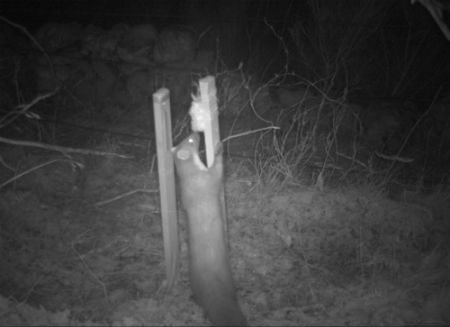
“I had similar experiences checking the other bait stations finding photos of pine marten, badger, deer, stoat and buzzards. But in the first four weeks of my camera traps being live still no sign of any wildcats. So when going out on the third trip after six weeks of the cameras being live I had become convinced that, although the habitat was great for pine marten, I probably wasn’t going to find any cats. This made it even more of a shock when upon checking one of the cameras it had some cat photos!
“The photos showed a tabby cat with a fat and faintly-striped tail, but with more blotches than stripes and a white/light chest patch, my first thought was it will be an obvious low-scoring hybrid, or even possibly a domestic cat.
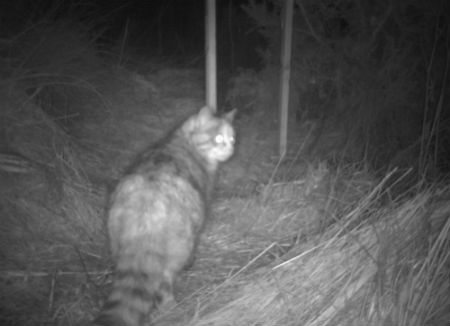
“It was great to see these cat photos justifying my reasons for where to place the trail camera and perhaps there was still hope for my other cameras to capture some cat photos. I was right in thinking so because other cameras I checked that week had cat photos too. One cat visited a station that had been very popular with pine marten previously. This cat was a tabby but with long hair making it seem like it has a mane of sorts, a very strange looking cat and with only one photo so far to judge it’s highly unlikely to be a possible wildcat. However, it’s still important to find hybrid wildcats for the next part of the project; to trap neuter vaccinate release (TNVR) feral domestic cats and obvious hybrids.
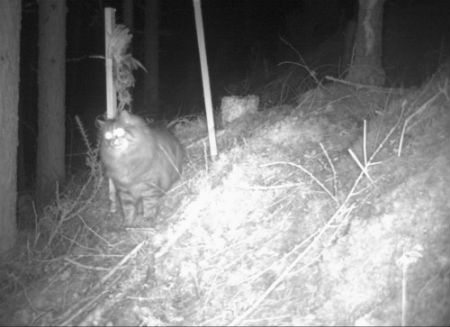
“The camera set up near cat prints in the snow also had a photo of a cat, although this white cat was obviously a domestic cat, and the clearly-visible collar means it will not be a target for TNVR.
“With my final camera checks nearly completed, I still had my fingers crossed to find possible wildcats. I decided to leave a camera running for an extra two weeks, in case a wildcat made an appearance. I’m pleased to say that my persistence was rewarded!
“Although this cat has not yet been ‘pelage scored’ (pelage is the fur, hair, or wool of a mammal). The scoring process is where certain coat or pelage characters are given a score based on how hybridized they are, which classifies the cat as Domestic, Hybrid, or Wildcat.
“The distinct stripes on the tail, presence of a dorsal stripe down the back, and stripy flanks and hindquarters, definitely suggest a possible wildcat or higher-scoring hybrid cat. The Project Officer for this area will now compare the videos and photos to other images found during the survey, to find out how many different individuals there were, and where they were found.
“The cameras and SD cards need to be collected from all the survey volunteers (79 cameras for Strathpeffer, and over 300 SD cards!) and then the data analysis can begin. The winter surveys will be repeated for five years to estimate wildcat population density for the area, and to help target conservation action, such as the ongoing TNVR schemes to help preserve Scottish wildcat genes.
“My volunteer experience has been thoroughly rewarding so far and I have signed up to help with education, community engagement and TNVR once the winter surveys for this year have concluded. It’s such an interesting project to be involved with and a huge undertaking to try and find out how many genetically viable Scottish wildcats actually remain in the wilds of Scotland.”
If you would like to find out more information about the work Scottish Wildcat Action are doing or if you think you have spotted a wildcat and would like to report a sighting, please visit the Scottish Wildcat Action website.
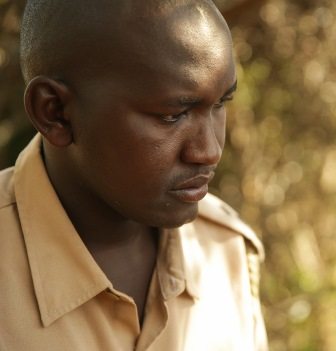
Can you please introduce yourself to me and tell me how long you have been working as a ranger for Big Life?
I am currently the head of the Big Life rhino programmes. I started working for Big Life in 2003. I started as a very, very young junior ranger, when I started with Big Life I was the youngest ranger in a team of 15. At that time, I was 17 years old.
How big is the area that you patrol?
It is over 200km square – so a pretty big area! It is very thick with a lot of forest, so it is a pretty hard area to patrol.
How long do you patrol on a daily basis?
We normally have two patrols per day. We start our normal morning patrol from 6am and the guys come back for lunch around 2pm. Then the next patrol goes out at 5pm and stays out all night. Normally, the night patrol is there to make sure that no one gets into the rhino area and lead ambushes on poacher’s hide outs. We also stay out on the hills to look around using thermal imaging.
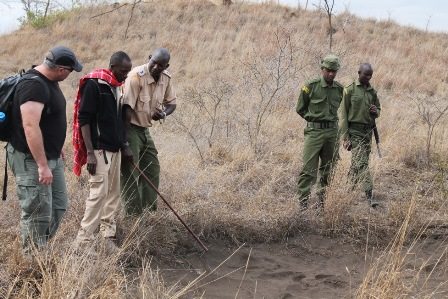
What are the daily risks that you encounter when you are doing your job?
As you know, rhinos are a critically endangered species in the wild. I have come across armed gangs two times. We have to make sure that they don’t see us before we see them. I have also been charged by a snared rhino that we were tracking down two years ago. He knocked me down but luckily I survived. I get chased by elephants every now and then but we take that as a normal daily routine, so it’s a pretty risky job that we do but we have to protect these animals. Working in the wild isn’t an easy job. I have grown up here, so it is kind of like an office job that I am doing but I love it a lot.
Can you tell me a little about some of the individual rhino that you are working to protect?
We have a big bull called Dixon, he is really really big. He is a really nice bull but he is really aggressive. Normally, black rhino are pretty aggressive. We have another called Cathy, we have named her after a lady that has been looking after us and giving us a lot of sponsorship from Save the Rhino. We also have another called Chester, of course!
Why is your job so important in helping these animals?
My job is pretty important for the whole ecosystem. If it wasn’t for us, the Big Life rangers, the Kenya Wildlife Service rangers, there would be no animals and no rhinos in Chyulu. We have so many people coming in, we have caught many of them on camera traps and they are all targeting rhinos. They bring in guns and the local people living on the other side of the hills, they sometime use poisoned arrows and put up big snares on big trees on rhino pathways. The rhino end up getting caught in these snares and end up dying. So, if it wasn’t for us, I would say that there would be no rhino left in Chyulu hills.
Do you think the poachers have become smarter and trickier to catch as technologies have developed?
You know, they haven’t really changed their ways too much; they are still using guns and putting up snares. You know, snares are a very silent and deadly way of killing rhino. Our rhino area is very very big and very thick so if a rhino is snared, it is really difficult for us to find – it is a really smart way of killing rhino. A year ago, a poacher was caught in Nairobi – he has a silencer on his weapon and he had GPS coordinates of rhino activities. So you see, they have all the equipment that we have in the field. So they are getting smarter and smarter by the day. We are trying to be always one step ahead of them but with their access to this technology, it is becoming very challenging.
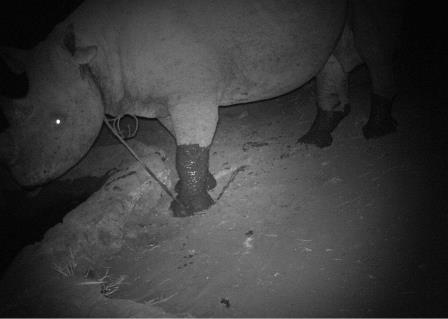
How do you think rhino poaching and international trade are linked?
For someone to get money – if a rhino is killed, they normally end up going out to Middle Eastern countries or maybe even Vietnam or China. We have been trying to investigate by catching poachers and using their cell phone contacts to find the people responsible. For example, there was one guy who we found was very aware of illegal trade and was caught by the Kenyan government with tonnes and tonnes of elephant ivory. Even a very minor guy on the ground has these contacts. So I would say that rhino poaching is mostly linked to international wildlife trade on the black market.
How are local communities helping you to protect the rhino?
I would say that 85% of successful Big Life operations come from the community. We have the community informants – someone sees an unusual person coming in, either someone who is armed or a strange looking car that doesn’t come from this area, they normally give us a call to tell us “this car with this registration number was spotted here and they did, X, Y and Z,” or “we have seen this person”. If everything goes well, we often end up capturing and arresting people based on the information from the communities. We have to give them a very good incentive and they are doing a really fantastic job. They are doing a very very important job in helping us conserve our wildlife.
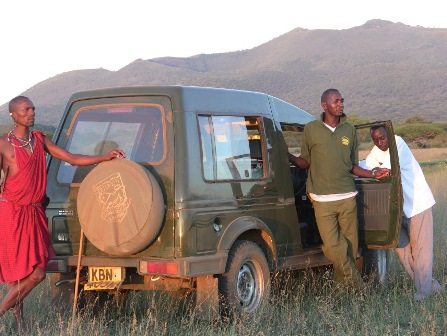
How many rangers are there working in Chyulu Hills National Park with Big Life at the moment?
In Chyulu itself, we only have 68 rangers. The rest are scattered everywhere. We have 31 different ranger outposts scattered across the whole of the Tsavo / Amboseli ecosystem in Kenya, covering a total of 1,678,000 acres, which is not a small area.
What’s the best thing about your job?
The best thing about my job…well, I grew up here, I went to school here and I am working with my community. I am conserving the wildlife that one day my kids or grand-kids might end up saying, ‘if it wasn’t for my Dad or my Grandad, we would never have seen this wildlife’. I am very much proud to be working within my community area, working with my people and to be saving something’s life.
It’s therefore important that we provide our visitors with opportunities to discover and learn about the biology and conservation of the species found here at Chester Zoo.
Wildlife Conservation is at the heart of everything we do. We use scientific evidence to help identify and address many of the challenges our natural world faces. We aim for our conservation research to help in decision making that improves the management of the animals and plants in our care-influence the sustainability of wild populations and inspire others to be motivated to join us in our challenge to Act for Wildlife.
Through visitor and community engagement we can tell people not only about the animals here at the zoo-but also their conservation status around the world and aim to inspire them to help make a difference – possibly inspire the next generation of conservation scientists!
That’s why we asked the question: “Are interactive activities for zoo visitors effective education tools?”
Due to the vast amount of variability among visitors-investigating the effectiveness of our educational initiatives can be difficult. One of the scientific studies carried out by a member of our discovery and learning team-evaluated the impact of informal learning practices and interactive activities in a zoo environment and identified variables that impact positively on the experience.
Two interactive activities at the zoo were evaluated. Both focussed on two species of critically endangered frog: the mountain chicken and the golden mantella.
Sarah Bazley-learning manager at Chester Zoo-carried out the research – here she tells us more about these amphibian themed activities:
“Although both activities are focussed around conservation efforts of critically endangered frog species-the species are not well known to the majority of visitors; their common names are unusual and don’t obviously describe them.
“There is a selection of field equipment and artefacts for visitors to explore and a member of the zoo ranger team is there to engage and discuss field conservation techniques employed to help each species.
“The mountain chicken activity revolves around the story of field researchers who monitor these frogs in the wild. These researchers microchip the frogs for identification purposes; health check the frogs by weighing and measuring the individuals found; and put transmitter belts on the frogs to track where they are and their survival rates.
“The activity at the zoo uses a number of toy frogs that have been microchipped and weighted. Visitors use the microchip scanner to firstly identify the frogs-then use Pesola scales to weigh and calipers to measure them. Our team also show photos on an iPad showing the researchers using the same equipment and same techniques in the field and there is a prototype of the transmitter belts used on the frogs for visitors to also look at. The zoo ranger is there to engage with visitors and guide the activity around this story.
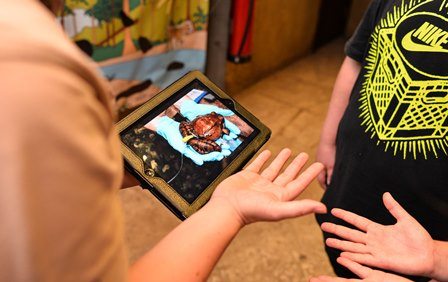
“The golden mantella activity revolves around the story of field researchers who are monitoring the populations of these frogs in the wild. As you may have seen on a previous blog-our conservationists are able to monitor golden mantella populations in Madagascar using an innovative technique of using a silicone implant that glows under UV light.
“The activity we run in the zoo involves a number of toy frogs marked with UV ink-so not obvious to the naked eye-and visitors use a UV torch to identify the marked individuals. A number of transparent toy frogs have been injected with the silicone and the equipment used is there for visitors to look at. Visitors can have their hand stamped with UV ink-and use the torch to reveal a frog outline on their own hand. Photographs on an iPad show the researchers using the same equipment and same techniques in the field-and the zoo ranger is there to engage with visitors and guide the activity around this story.”
Sarah interviewed a number of visitors using a series of open and closed questions designed to explore factors that may impact on informal learning in a zoo environment including; motivation for visit-prior knowledge-what the visitors found out during their visit and knowledge of amphibians and their conservation (in particular the amphibians focussed on in the activity) and awareness of Chester Zoo’s conservation work.
Individuals were interviewed on days the activities weren’t available to act as a control. We found that visitors that engaged with interactive learning activities achieved stronger learning outcomes regarding their knowledge of endangered animals-but little impact was observed regarding knowledge of Chester Zoo’s conservation efforts.
It is possible that this was due to the high awareness already established in most of the visitors. Moreover-those that had visited the zoo with motivations to ‘see the animals’ appeared to gain more from the interactive activities than visitors with alternative motives.
Following the results of this study-recommendations were made to continue using learning and interactive elements to informal learning delivery at the zoo but as there appears to be a particular group of visitors that benefit from interactive learning-activities designed to target specific audiences would be ideal.
Chester Zoo’s golden mantella frogs are playing an increasingly important role in conservation as their species is critically endangered in the wild. The reintroduction of endangered species into their natural habitat has sometimes proved difficult – it’s not just as simple as putting them back in the wild.
By evaluating the ‘fitness’ of the zoo population of golden mantella we can then improve the success of reintroduction attempts. Chester Zoo Conservation Scholar Luiza Passos is a PhD student at the University of Salford. She has been working closely with our curator of lower invertebrates and invertebrates, Gerardo Garcia, and team manager of lower vertebrates and invertebrates, Ben Baker, to evaluate the population of golden mantella at the zoo.
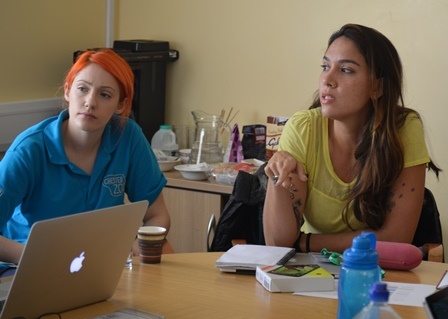
Luiza Passos (right) at Chester Zoo discussing her research with staff
Their research involves measuring the characteristics of golden mantellas, such as color patterns, vocalisation, body condition and behaviour at the zoo, and comparing this to the information gathered in the field in Madagascar. The aim is to increase our understanding of where conditions can be enhanced to ensure optimal fitness for future in-situ generations of golden mantella.
Below Luiza tells us more about her research:
“In zoo conservation breeding and reintroduction is becoming a high profile conservation tool for many species threatened with extinction. However, before reintroducing any species back into the wild, research is needed to help make more informed decisions and improve the success rate.
“The reintroduction of endangered species into their natural habitat has proved difficult. If animals are to be released into the wild these questions need to be addressed. With this in mind I decided to target my PhD research on measuring the characteristics of golden mantellas at the zoo and comparing these to the information gathered in the field in Madagascar.”
The aim of Luiza’s research is to increase our understanding of where conditions can be enhanced even further to ensure optimal fitness for future in-situ generations of golden mantella and increase the success of reintroduction programmes.
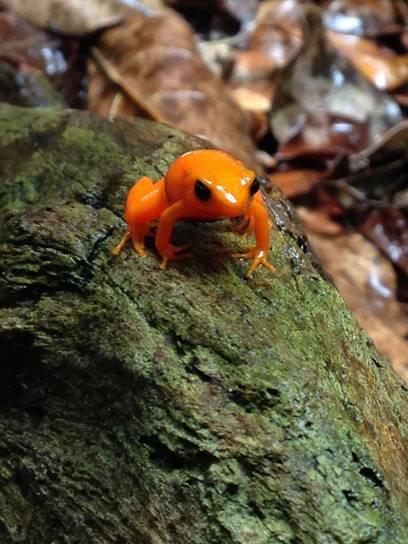 Golden mantella frog. Photo credit: Luiza Passos
Golden mantella frog. Photo credit: Luiza Passos
“The species I focused my research on is the golden mantella frog (Mantella auriantaca) from Madagascar. These amazing little creatures are endemic to Madagascar and are currently considered by the IUCN Red List as ‘critically endangered’ due to habitat destruction (mainly mining) and over exploitation for the pet trade market. Reintroduction is one of the many conservation tools described on the species’ conservation action plan to help save it from extinction in the wild.
“I will be analysing a variety of characteristics that are crucial for the survival of golden mantellas in the wild such as:
Skin coloration – this is important for finding a mate and keeping predators away.
Skin microbiota – this is a measurement of their immune system capabilities.
Vocalisations – this is important for attracting a mate.
Body condition – this shows how healthy individuals are.
“Data from a healthy wild population is being used as a baseline for comparison with a variety of populations in the UK and Madagascar. I have already had the opportunity to go to Madagascar twice in for fieldwork to collect data from a wild population. Field work in Madagascar is a truly amazing experience; waking up each day to the sound of indri lemurs and seeing all these tiny orange frogs hoping around the forest floor is just beyond words! The fieldwork is done in partnership with Chester Zoo’s project partners Madagasikara Voakajy.
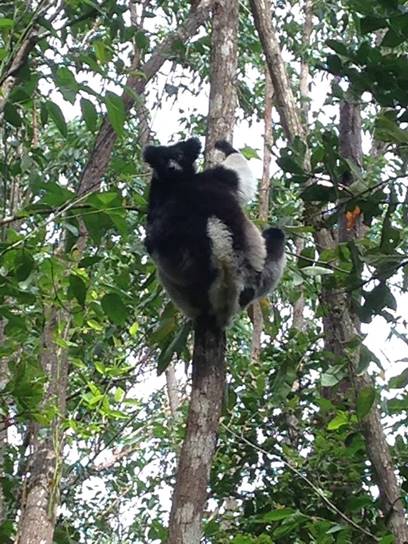 Indri lemur. Photo credit: Luiza Passos
Indri lemur. Photo credit: Luiza Passos
“On my second trip to Madagascar I also had the opportunity to visit Andasibe and collect data from a conservation breeding centre at the Mitsinjo Association. Housed at Mitsinjo is a founder population of golden mantellas and their first offspring as a genetic resource, or safety net population, for future reintroduction programmes.
“In addition to fieldwork in Madagascar I have also been collecting data from the population at Chester Zoo to be compared with wild and Mitsinjo’s animals. At the moment I am analysing all the data I have collected from all these different populations to be able to understand when reintroduction would be a viable option for this species. I already have some preliminary data, which shows some reassuring results, such as the fact that the Chester Zoo population is very healthy. There is still a lot of work to be done in my PhD before I have some definitive conclusions. I’ll keep you updated with progress of my research.”
If you want to hear more from Luiza and learn more about her PhD work – which is funded through a scheme based in Brazil called ‘Science without Borders’ – watch this video created by the University of Salford.
Having read our previous blog you’ll know just how important it is to keep an eye on the wildlife around you.
Here are a few more suggestions on how to get the most out of wildlife watching:
- Do get friends and family involved; the more the merrier! Be careful not to disturb any animals and plants.
- Don’t be too invasive or try to catch anything. It’s important to keep your distance so you don’t frighten anything away, plus it means you get to observe the animal for longer!
- Do count how many individuals of a species you see and where you spot them. Not only is it important for experts to know what type of animal or plant you find, numbers also give experts a more accurate idea of what’s going on. Why not keep a simple recording sheet with you so you can note down anything you see – what was it, how many were there, when did you see it and where you saw it?
- Don’t worry if you’re not 100% sure what species of animal or plant you’ve spotted. If you’ve spotted something that isn’t listed on our recording form then try to identify it by typing a more detailed description into Google or using a guide book. Or take a photo and send it to us for our volunteers to identify.
- Do try to record wildlife on a regular basis. Knowing what you have in your garden already will help when planning what changes to make. You’ll also notice different animals and plants appearing as the seasons change throughout the year.
- Don’t forget to make your garden more wildlife friendly. Just by creating places to hide and providing food that birds, mammals and insects like, you’ll be able to encourage more wildlife in to your garden. We’ve got lots of ideas here on our site and links to other organisations where you might be able to find more information.
- Do look out for wildlife signs – you don’t have to see the actual animal to know it’s there. Look out for other evidence of animals, like footprints and droppings. These are big clues as to what animals are visiting your garden. Other things you can do are listen out for clues as to what wildlife is around you. You may hear a bird call without seeing the bird or find spawn without seeing a frog.
- Do remember to be patient when looking out for wildlife, it might take a while for a butterfly or bird to find a spot in your garden where it feels comfortable landing.
- Do be aware that if you do make changes to your garden or space and are hoping to see new visitors it can take weeks, months or even a year or two before you start getting new inhabitants. Birds and insects that can fly can find a new home quickly, but things that have to walk will take longer.
- Do remember that it is just as important to record the more common species you see. There are plenty of experts and professionals carrying out research full time on rare UK wildlife, so in order to get a more realistic idea of numbers we need the common species to be accounted for too.
When is the best time to record wildlife?
All year round. We need to record wildlife continually so we have benchmarks, track changes in behaviours or habitats and spot new trends.Some species are seasonal, like swallows for example, and you might miss them if you only record at one time of year.
What happens to your records?
We work closely with RECORD and Cofnod – our Local Environment Records Centres – which cover Cheshire and North Wales. The information you send in to us will be used to help inform conservationists and other organisations in making accurate decisions for conservation. The more data they have to work with the more informed these decisions can be!
Careful planning, top class facilities, skilled zookeepers and animal staff, first rate husbandry and scientific insight are all contributing factors to the baby boom of endangered and unusual species this year.
1. Eastern black rhino calf, Gabe
After a pregnancy lasting 15-months, Ema Elsa, an Eastern black rhino, gave birth to male calf Gabe.
The footage of the birth was caught on CCTV, and showed the youngster landing safely on deep sand on what our keepers described as the “perfect” birth.
Black rhino populations have dropped by more than 95% over the last 50 years due to a global surge in illegal poaching for their horns, which continues to devastate the species.
The species is critically endangered with their wild numbers currently estimated at just 740 across Africa.
Tim Rowlands, curator of mammals, said:
The footage picked up by our CCTV cameras gave us a rare glimpse of a momentous event – a birth which provides a big boost to the European Endangered Species Breeding Programme (EEP) for the magnificent Eastern black rhino. These animals are on the very brink of extinction and our new arrival is hugely important to the conservation of the species.
Gabe is now almost one year old and is doing tremendously well.
2. Rare tuatara hatches
The hatching of an incredible species known as the tuatara was the first ever breeding of the animal outside of its native New Zealand. The species is believed to have pre-dated the dinosaurs.
The rare newcomer arrived weighing just 4.21 grams following a 238 day incubation period.
Our reptile experts described the hatching as an “amazing event” after dedicating several decades to the project.
Found wild only in New Zealand, the tuatara is the last surviving species of its group. Its relatives died out more than 225 million years ago. At that time, the creatures were also found in Europe, Asia, North and South America and parts of Africa and it is not entirely clear how and why the rest of these ancient reptiles became extinct.
3. Penguin chicks: Munch, Frazzle, Squares and Wotsit
Fuzzy Humboldt penguin chicks – Munch, Frazzle, Squares and Wotsit – were named after their keepers favourite crisps!
We use a different naming theme each year to help them to keep track of the new chicks, with popular potato snacks getting the nod this time around. Previous topics have included British Olympic athletes, chocolate bars and even the keepers’ favourite curries.
We fund conservation initiatives in South America, where the species is threatened by climate change, rising acidity levels in the ocean and over-fishing – all of which is forcing them to search further from their nests for fish.
4. Javan green magpie first
The breeding of four rare Javan green magpie chicks gave a huge boost to conservation efforts to save the critically endangered birds from extinction.
It was the first time that the world’s rarest magpie had ever been bred in a UK zoo when the precious quartet hatched in summer.
Conservationists and bird staff at the zoo have started the first ever breeding programme for the birds and are making every effort to try and save the species, which has been trapped to the very brink in its native Indonesian forests.
Andrew Owen, the zoo’s curator of birds, said:
I have had the privilege of working with many rare and beautiful birds, but none are more precious than the Javan green magpie – one of the world’s most endangered species.
We’ve been working with our conservation partners in Java – the Cikananga Wildlife Centre – for several years. In that time we’ve seen Javan green magpies disappear almost completely from the wild as they are captured for the illegal bird trade. Huge areas of forests that were once filled with beautiful songbirds are falling silent.
Every individual we breed at the zoo could help save the species as the clock is ticking and time is running out.
5. Montserrat tarantulas
Keepers at Chester Zoo were the first in the world to successfully breed the rare and unusual Montserrat tarantula.
The clutch of 200 spiderlings was a crucial step towards discovering more about the mysterious species.
Native to the Caribbean island of Montserrat, very little information is known about the species and how it lives.
Dr Gerardo Garcia, curator of lower vertebrates and invertebrates at the zoo, said:
Breeding these tarantulas is a huge achievement for the team as very little is known about them. It’s taken a lot of patience and care to reach this point.
The data we’ve been able to gather and knowledge we’ve developed over the last three years since the adults first arrived has led us to this first ever successful, recorded breeding and hopefully these tiny tarantulas will uncover more secrets about the behaviour, reproduction and life cycle of the species.
6. Malayan tapir, Solo
Tiny Malayan tapir Solo was the first of her kind to ever be born at Chester Zoo.
The spotty and stripy youngster was pictured taking her very first outdoor adventure under the watchful eye of mum Margery.
Solo’s arrival is hugely significant as she will add valuable genetics to the European endangered species breeding programme which is working to ensure a safety net population of Malayan tapirs in zoos, ensuring they will not go extinct.
7. Beautiful Asian elephant calf, Indali Hi Way
Our family of Asian elephants welcomed the pitter patter of not-so-tiny feet as Christmas came early in the shape of a new calf in late December.
The female calf, named Indali Hi Way by keepers, arrived to 12-year-old mum Sundara after a 22-month gestation.
Richard Fraser, assistant team manager of elephants, said the birth was as “great family occasion” and particularly special for one-year-old half-sister Nandita who was witnessing a birth for the very first time.
There’s always a lot of excitement among the elephants whenever there’s a birth. It’s a hugely positive event for the herd – not least for young Nandita who was experiencing a new arrival for the very first time. Having a new play mate around means that Christmas really has come early for her!
The new calf gives a huge boost to the endangered species breeding programme for Asian elephants, which are listed as endangered on the International Union for the Conservation of Nature’s (IUCN’s) Red List. The species is threatened by habitat loss, poaching, disease and direct conflict with humans.
We’ve been working in Assam in India for over a decade on projects which are successfully helping to protect wild elephants and the people who live with them. We’re hoping our latest arrival can help raise more awareness of the species – and the threats they are facing.
8. Han, a critically endangered Sulawesi crested macaque
A baby Sulawesi crested macaque, called Han, was spotted clinging to first-time mum Camilla in May.
The youngster was born as part of a European breeding programme for the critically endangered species of monkey.
The species is highly threatened with extinction in the wild, with fewer than 5,000 estimated to remain on its native island of Sulawesi due to large scale habitat loss and illegal poaching. Our new arrival increased the number of Sulawesi crested macaques living in our South East Asian Islands habitat – the biggest development in the history of UK zoos – to 16.
9. Rare twin Visayan warty piglets
Twin Visayan warty piglets – a species listed by conservationists as critically endangered – made their debut in spring.
Recent estimates suggest just 200 warty pigs are left in their native habitat in the Visayan Islands in the central Philippines – making them the rarest of all wild pigs. The decline of the species is blamed mostly on habitat loss and hunting.
The new piglets were among the first to be born in the our Islands habitat.
10. Adorable otter pups
Five baby otters were thrown in at the deep end while being taught how to swim by their parents.
Mum Annie and dad Wallace took their new pups for a debut dip in water after emerging from their dens with them for the first time in October.
Asian short-clawed otters, which are found in various parts of Asia from India to the Philippines and China, are listed by the International Union for the Conservation of Nature (IUCN) as vulnerable to extinction.
As well as a successful record with breeding exotic otter species, we have also helped fund research and conservation projects in Cheshire to monitor and safeguard native otter populations which are distant relations of the Asian short-clawed species.
The female calf arrived to 12-year-old mum Sundara after a 22-month gestation and was on her feet within minutes. The youngster was welcomed by the rest of the elephant herd, including one-year-old half-sister Nandita who was witnessing a birth for the very first time.
Our keepers say both mum and daughter, who has been named Indali, are doing well.
Asian elephants are listed as endangered on the International Union for the Conservation of Nature’s (IUCN’s) Red List, threatened by habitat loss, poaching, disease and direct conflict with humans. The new calf is a huge boost to the endangered species breeding programme.
Richard Fraser, assistant team manager of elephants, described the birth as “perfect” and a “great family occasion.” He said:
The arrival of a calf is a great family occasion for the elephant herd and brings the whole group together. As soon as Sundara began showing early signs of labour, you could see the rest of the family knew something special was about to happen.
This was Sundara’s second pregnancy and the birth was pretty much perfect. She delivered Indali onto soft sand with all the family gathered around. Sundara then gave her a series of little kicks to gently stimulate and encourage her to her feet. Minutes later, the new arrival was up and standing and making her first attempts to suckle.
There’s always a lot of excitement among the elephants whenever there’s a birth. It’s a hugely positive event for the herd – not least for one-year-old Nandita who was experiencing a new arrival for the very first time. Having a new play mate around means that Christmas really has come early for her!
We’ve been working in Assam in India for over a decade on projects which are successfully helping to protect wild elephants and the people who live with them. The zoo now hopes their latest arrival can help raise more awareness of the species – and the threats they are facing.
Mike Jordan, collections director, added:
Sundara’s new calf is a fantastic addition to the zoo’s Hi Way family of elephants and we hope that news of her arrival will generate more much needed awareness of these incredible animals and the pressures for survival that they are faced with in the wild.
In India, Asian elephants are regularly injured and killed in conflicts with humans. They wander into villages, destroying crops and property as they go and this often results in forceful retaliation by villagers. Chester Zoo’s conservation work in Assam in northern India is, however, successfully helping to mitigate these problems, finding effective ways for people and wild elephants to live side-by-side.
Chester Zoo is part of a breeding programme coordinated by the European Association of Zoos and Aquariums (EAZA) that is focused on sustaining the elephant population in Europe.
Our elephant house is open as normal.